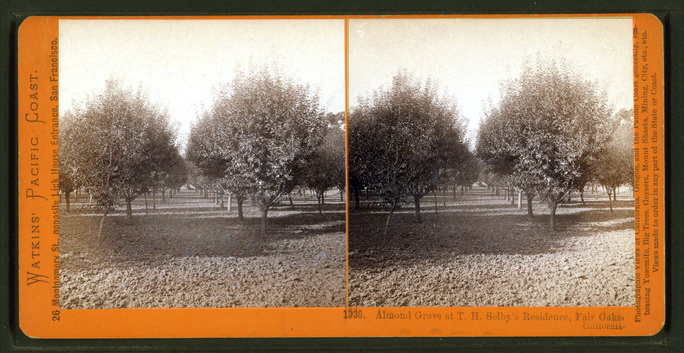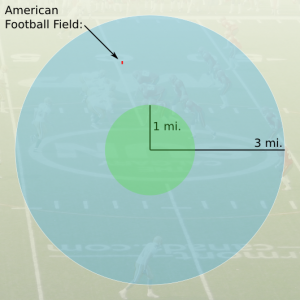
Californians have grown almonds for a long time. “Almond Grove At T. H. Selby’s Residence, Fair Oaks, Cal.” ca. 1870. NY Public Library
2006 was something of a banner year for both beekeepers and growers. A high fraction of beekeepers experienced better than 50% losses. Many growers could not rent bees at any price. Lots of almond groves in California went without pollination that year, and, as with many species of nuts, if the pollen isn’t carried over from an unrelated plant, nuts do not develop. Almonds, like many crops, (and most nuts) do not self-pollinate. Unless pollinated by an agent like a honey bee, they just don’t bear fruit. The price of almonds shot up in 2006 and has not dropped very much since.
CCD Defined
The trouble is, the usual suspects in bee kill-offs, Varroa mites, Nosema, Israeli Acute Paralysis Virus, didn’t claim more than the usual number of hives that year. Many of the hives seemingly self-depleted. It’s as if the bees did a Mary Celeste abandoning well-stocked and apparently healthy colonies, never to return, to (presumably) die out in the open. It’s like they forgot to go home.
Strictly speaking, the characteristics of CCD are defined by the U. S. Department of Agriculture, as:
- Post collapse, the colony still has a live queen bee
- Honey stores are sufficient, even abundant
- Broods are still alive in capped cells
- There are hardly any worker bees; the few around are generally very young, “just hatched” specimens
- There are no bodies in the hives – whatever happened to the worker bees happened while they were in the field.
Unfortunately, and we’ll revisit this point later, many many writers new to the topic don’t speak – or write strictly. CCD is distinct from another phenomenon, Absconding, where bees also leave the colony en mass. Absconded hives are also void of bees, but for good reason. The foraging in the locale no longer supports the hive, so Queen, drones, workers leave. The reason is simple: they’re starving. Because they’re starving, the hive lacks broods and food stores. Absconding is a move of desperation. Starving, absconding bees rarely discover greener pastures before they drop from lack of food. Such hives differ from the USDA definition of CCD in points 1, 2 and 3, but these fine points are often lost on many observers, who more or less equate empty colonies with CCD. This obscures the issue and makes it more difficult to quantify how much, and where, CCD is happening.
While technically still a ‘live’ colony, a CCD afflicted colony will inevitably die. Queen bees only know how to lay eggs. They briefly know how to fly and have sex, but after they have cached enough sperm to last a lifetime – a few years – they quit sex, fly only to swarm, and mainly just lay eggs. They do not know how to feed themselves. Without worker bees, they starve. Without worker bees, the brood starves as well. In a matter of weeks, a CCD struck colony dies the rest of the way.
It Is A Tough Job, But Somebody’s Got To Do It.

Minimum and maximum foraging radii for a typical western honey bee, compared to an American Football field (with end zones).
CCD is a name for a bunch of conditions. It explains nothing. As of this writing, there is no one settled opinion on why CCD happens, but lots of theories are floating around. Winnowing theories down with facts is a tough game because the phenomena doesn’t take place in carefully controlled laboratory conditions. Much of what happens, what could matter, cannot be observed. It’s out there, somewhere. We don’t know what it is; we just see the effect: bees failing to return to hives that otherwise seem healthy and robust.
To be sure, the modus operandi of Apis mellifera doesn’t help. The western honey bee, the mainstay pollinator in the American agriculture business, is a natural materials aggregator. Bees typically range from one to three miles from their hives, covering areas of about 2,000 to 18,100 acres. A standard American football field, including end zones, is about 1.32 acres, so an average hive of about 40,000 to 80,000 bees will range over about 1,500 to 14,000 football fields. They can increase the weight of the hive by fourteen to thirty two pounds over eighteen days. They can accumulate all kinds of crap into one place.
It is possible that ambient amounts of insecticides, long after application and far below concentrations that would harm a honey bee or any other insect, may be raised to sub-lethal, but still damaging levels by the normal business of bees gathering nectar — and concentrating pesticides. In addition to pesticides, the kinds of things so concentrated include parasitic mites and the viral diseases which they carry. The agent may be something new in the witches brew of chemicals our complex civilization releases into the environment, something, perhaps, entirely unrelated to agriculture.
Sherlock Holmes would rate it as a three pipe problem. Alas, the air of his quiet Baker Street study is not to be found. Bees, and their infamous disappearing act, is at the crux of a lot of money, money that won’t get made should bees really, really disappear. So the air is not quiet. It is rather like the moment when people are thinking the Ponzi scheme is going flat and maybe they’re the ones who got in the game a little late. There is an awful lot of finger pointing going on. Next on tap, the fingers, whom they’re pointing at, and from whom they’re pointing.
Previous: The Case Of The Disappearing Bee
Next: Words Of The Chattering Classes